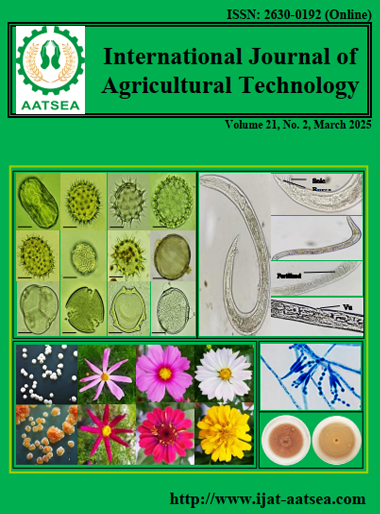Yield and artemisinin content of six polyploid accessions of Artemisia annua grown at medium altitude in Indonesia
Main Article Content
Abstract
The high incidence of malaria in Indonesia has resulted in a very high dependence on malaria drugs. The effort to self-sufficiency in artemisinin raw materials has been very possible because of the suitable geographical climate for large scale cultivation of Artemisia annua. Artemisinin production would be efficient and economical if the content levels reach more than 0.6%. Artemisia annua is a short-day plant, which is a typical of sub-tropical plant. Growing this species in the tropics causes a short vegetative period and results in low levels of artemisinin. The results showed that 6 polyploid accessions of Artemisia annua grown in medium altitude in Indonesia demonstrated different morphological characteristics based on growth, leaf shape, branching, stem colour, and flowering characteristics. Each of evaluated accession performed growth, yield, and artemisinin content, inconsistently. Artemisinin levels of each individual sample of each accession were highly fluctuated indicating that each accession number was not genotypically stable or uniform. Further evaluation is required to determine a suitable accession to grow.
Article Details

This work is licensed under a Creative Commons Attribution-NonCommercial-NoDerivatives 4.0 International License.
References
Banyai, W., Kirdmanee, C., Mii, M. and Supaibulwatana, K. (2010). Overexpression of farnesyl pyrophosphate synthase (FPS) gene affected artemisinin content and growth of Artemisia annua L. Plant Cell, Tissue and Organ Culture (PCTOC), 103:255-265.
Brisibe, E. A., Udensi, O., Chukwurah, P. N., de Magalhäes, P. M., Figueira, G. M. and Ferreira, J. F. S. (2012). Adaptation and agronomic performance of Artemisia annua L. under lowland humid tropical conditions. Industrial Crops and Products, 39:190-197.
Čertner, M., Fenclová, E., Kúr, P., Kolář, F., Koutecký, P., Krahulcová, A. and Suda, J. (2017). Evolutionary dynamics of mixed-ploidy populations in an annual herb: Dispersal, local persistence and recurrent origins of polyploids. Annals of Botany, 120:303-315.
Chen, G., Wang, S., Huang, X., Hong, J., Du, L., Zhang, L. and Ye, L. (2015). Environmental factors affecting growth and development of Banlangen (Radix isatidis) in China. African Journal of Plant Science, 9:421-426.
Delabays, N., Benakis, A. and Collet, G. (1993). Selection and breeding for high artemisinin (qindhaosu) yielding strains of Artemisia annua . Acta Horticulturae, 330:203-208.
Delabays, N., Simonnet, X. and Gaudin, M. (2001). The genetics of artemisinin content in Artemisia annua L. and the breeding of high yielding cultivars. Current Medicinal Chemistry, 8:1795-1801.
Elhag, H. M., El‐Domiaty, M. M., El‐Feraly, F. S., Mossa, J. S. and El‐Olemy, M. M. (1992). Selection and micropropagation of high artemisinin producing clones of Artemisia annua L. Phytotherapy Research, 6:20-24.
Ferreira, J. F. S., Benedito, V. A., Sandhu, D., Marchese, J. A. and Liu, S. (2018). Seasonal and Differential Sesquiterpene Accumulation in Artemisia annua Suggest Selection Based on Both Artemisinin and Dihydroartemisinic Acid may Increase Artemisinin in planta. Frontiers in Plant Science, 9.
Ferreira, J. F. S., Laughlin, J. C., Delabays, N. and Magalhães, P. M. de. (2005). Cultivation and genetics of Artemisia annua L. for increased production of the antimalarial artemisinin. Plant Genetic Resources, 3:206-229.
Ferreira J, F., Simon, J. and Janick, J. (1997). Artemisia annua: Botany, horticulture, phamacology. In Horticulture Reviews: Vol. 19 (pp.319-371). John Wiley and Son.
Graham, I. A., Besser, K., Blumer, S., Branigan, C. A., Czechowski, T., Elias, L., Guterman, I., Harvey, D., Isaac, P. G., Khan, A. M., Larson, T. R., Li, Y., Pawson, T., Penfield, T., Rae, A. M., Rathbone, D. A., Reid, S., Ross, J., Smallwood, M. F. and Bowles, D. (2010). The genetic map of Artemisia annua L. identifies loci affecting yield of the antimalarial drug artemisinin. Science (New York, N.Y.), 327:328-331.
Graz, B., Willcox, M. L., Diakite, C., Falquet, J., Dackuo, F., Sidibe, O., Giani, S. and Diallo, D. (2010). Argemone mexicana decoction versus artesunate-amodiaquine for the management of malaria in Mali: Policy and public-health implications. Transactions of the Royal Society of Tropical Medicine and Hygiene, 104:33-41.
Gusmaini, G., and Nurhayati, H. (2015). Potensi Pengembangan Budidaya Artemisia annua L. di Indonesia. Perspektif, 6:55-67.
Omer, E. A., Abou Husein, E. A., Hendawy, S. F., Ezz, E., Azza, A. and El-Gendy, A. G. (2013). Effect of Soil Type and Seasonal Variation on Growth, Yield, Essential Oil and Artemisinin Content of Artemisia annua L. International Research Journal of Horticulture, 1:15-28.
Salisbury, F. and Ross, C. (1995). Fisiologi Tumbuhan Jilid III (Terjemahan). ITB Press.
Shahrajabian, M. H., Sun, W. and Cheng, Q. (2020). Exploring Artemisia annua L., artemisinin and its derivatives, from traditional Chinese wonder medicinal science. Notulae Botanicae Horti Agrobotanici Cluj-Napoca, 48:1719-1741.
Simonnet, X., Quennoz, M. and Carlen, C. (2008). New Artemisia annua Hybrids with High Artemisinin Content. Acta Horticulturae, 769:371-373.
Sitompul, S. M. and Guritno, B. (1995). Analisis Pertumbuhan Tanaman. UGM Press.
Townsend, T., Segura, V., Chigeza, G., Penfield, T., Rae, A., Harvey, D., Bowles, D. and Graham, I. A. (2013). The use of combining ability analysis to identify elite parents for Artemisia annua F1 hybrid production. PLOS ONE, 8:https://doi.org/10.1371/journal.pone.0061989.
WHO. (2005). WHO Monograph on Good Agricultural and Collection Practices (GACP) for Artemisia annua L. WHO. 68p.
Widiyastuti, Y. and Subositi, D. (2019). Photoperiod Effect on the Growth and Artemisinin Content of Artemisia annua Grown in Tropical Region. AIP Conference Proceedings, 2099:020027. https://doi.org/10.1063/1.5098432.


